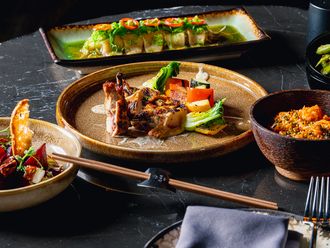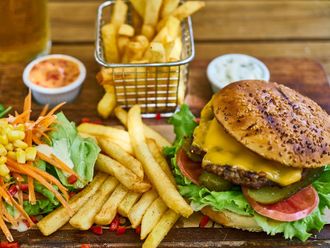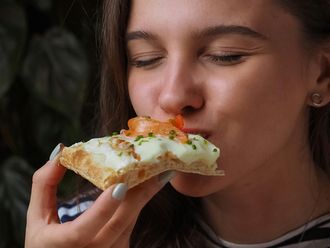To Philippe Gauvreau, 2 Michelin star chef, a signature dish is a mathematical calculation and opting for a gourmet meal is like trading an old sedan for posh wheels.
The only time Philippe Gauvreau, 2 Michelin star chef, bins a dish cooked by him is when it doesn't turn out the way he expects it.
Which, by his own admittance, is not very often.
But when he has to rework a recipe, he picks his notepad and pencil to embark on an exercise best described as a precise calculation to balance flavours, colours and textures.
On paper, it isn't a haphazard trial-and-error approach. Nor is it a happy accident of ingredients thrown together.
His recipes have an ossified method. First, it is a rough, mental calculation. Then, a final handwritten exercise.
Ergo the success ratio of a recipe based on random ingredients is zilch. Ditto for those which feature in his dreams.
"They never work!" laughs chef Gauvreau, owner of La Rotonde restaurant in Lyon, France, adding, "I try such recipes the following morning, but alas! I am glad all my recipes don't turn out right every time. Or else my job would be boring!"
Chef Gauvreau is visiting Café Chic, Le Méridien Dubai's signature restaurant. He visits the city three times a year to update the menu with his signature dishes. (He has been associated with the restaurant for three years.)
Earlier his visits were limited to the promotion period, where his dishes would feature on the menu during that time only. Now his signature dishes are available throughout the year. During this visit he also conducted a cooking demo for culinary enthusiasts.
"Most of the attendees were men," he says, sporting a tight-lipped smile. His statement elicits a repartee.
"Don't men cook out of vanity?" I ask, questioning that cliché about women being the best cooks, but men being the best chefs.
In a distinct French-English accent, chef Gauvreau, dressed in La Rotonde's uniform with emblazoned initials, defends, "There is no comparison. Most women cook at home. Whereas most men cook for commercial reasons. They are more confident (than women). I think these male attendees get bad food at home! Perhaps, they came to pick a few cooking skills for themselves."
Ironically, chef Gauvreau's choice of career has largely been influenced by a male chef - his uncle. He also learnt a few culinary lessons from his grandmother and mother.
"(My uncle), Francis, owned a pastry shop. On weekends, I would work for him to earn extra pocket money. It was during this time I developed a love for cooking," he says.
Today chef Gauvreau is a celebrity chef and author of cookbook Veaux, Vaches, Cochons et Compagnie.
In France, he worked with some of the most prestigious addresses in the culinary world - Le Bristol and Grand Vefour in Paris and Le Vieille Maison in Chartres.
He has cooked for famous personalities including French President Jacques Chirac, tennis stars Yannick Noah, Amelie Mauresmo and Mary Pierce, soccer player Michel Platini and super chef Paul Bocuse.
Celebrities or not, all guests are important, he says. "I don't change the dish because a guest is famous. The only part that may be considered fussy is the photo-op."
The making of a signature dish
Chef Gauvreau started his career at Chez Jo Rostang in France. He worked for nine chefs, including super chef Jacques Maximin. He joined La Rotonde in 1992, where he utilised his syncretic mix of old-style gastronomic cooking and passion for Mediterranean cuisine.
He received his first Michelin star courtesy chef Maximin. His second was at La Rotonde. "Maximin inspires me. He uses simple ingredients to make the most exquisite dishes," says chef Gauvreau.
Speaking of exquisite dishes, one of his signature dishes is the Lobster Tajine. "I created it more than a decade ago. I used 14 spices for the sauce. It is a classic favourite. People who taste it inevitably recommend it to their friends. It is served at La Rotonde and Cafe Chic," he says.
He proudly states he knows the taste of each ingredient. When he works on a recipe, he tries to achieve a synergy of tastes.
"I will not add strawberries to a lobster dish. In other words, I will not add an ingredient that doesn't compliment the dish in flavour and texture. I experiment with caution," he says, adding, "the weirdest ingredient I think is Fugu poison fish bone in saki."
Still, taste is fickle, and chefs have to work hard. What do chefs like Gauvreau do to stay ahead of the game?
"We have to be rigorous. Though I am still doing what I was 10 years ago, I have to work hard to maintain standard. For instance, the European market for fine dining restaurants is about gastronomic ratings (Michelin stars). These are taken seriously in the restaurant business.
"In France there are more than 450 restaurants with one Michelin star rating. There are more than 72 in the two-star category, and more than 23 in the three-star. Getting a three-star reputation is hard work. The competition is tougher," he says.
Chef Gauvreau wants to qualify for three-star status. "I need to change the set-up of the restaurant. I plan to relocate it to a new hotel - the Lyon Vert," he says.
Concept of seasonal menus
Natural essences, flavours and colours are the basis of chef Gauvreau's cooking. Creating a menu according to the season is his speciality.
So it is no surprise that the menu at Cafe Chic is tailored to European seasons. The surprising part is the UAE has no concept of seasonal food. (Most products are available all year round.)
Thus chef Gauvreau reasons, "(At Cafe Chic), we use high quality French products and rarely depend on local produce. We import 80 per cent of our ingredients, especially for our a la carte menu. We also change our menus according to the season. Darker sauces in winter and lighter ones in summer," he says.
Seasonal food is predictable, unlike palettes. "One night we prepare 20 or 30 lobsters. On another, none. We try to make our menus versatile so there is something for every kind of guest," he adds.
So there are dishes from the classic to the experimental. "In the culinary world, we have to work on presenting the unexpected too," he says.
Even prepare for unexpected events.
Like the time he had to cook for 360 guests in Lyon despite a power shutdown. "All the chefs cooked by candlelight. Luckily we had gas stoves. It was crazy, but we managed," he says.
Culinary trends
Being a chef is about adapting to the times. In the past people were conservative. In the nineties, multi-culturalism and globalisation have made people shed their conservative tastes. Now chefs are adventurous.
At present, molecular gastronomy or experimental cuisine is a trend, he says. "Chefs want tomato in powder form. Or they want to mix two polarised flavours to create a third distinct flavour.
"It is about creating new flavours in a laboratory. One chef who is on top of creating this kind of cuisine is Ferran Adrià. He spends more than six months in a laboratory and has 60 staff members."
But this is not chef Gauvreau's style. He borrows a few tenets from nouvelle cuisine. (This cuisine used to be popular in the late 1970s and 1980s. It focused on food presentation and visual appeal.)
"In the past, nouvelle cuisine was associated with a huge, white plate and a small portion of food. People would pay for the look rather than the taste. I assimilated the visual element and presentation (of nouvelle cuisine) along with high quality ingredients in my cooking."
Fine dining - an experience
Opting for a gourmet meal is like trading your old sedan for posh wheels, says chef Gauvreau. "You can tell the difference right away."
When a guest comes to a fine dining restaurant he expects something different and exquisite. He expects something greater than the sum of the ingredients served on his plate.
In his view, eating at a fine dining restaurant is an experience in totality. "Great detail is given to location, ambience, view, interiors, food, service, etc. People always ask why fine dining restaurants are so expensive.
For one, the ingredients used are of the highest quality. For example, we don't use frozen scallops. which are usually tough and chewy. This translates in the final price of the dish.
"Fine dining restaurants in the UAE are far more affordable than in Lyon," says chef Gauvreau, who enjoys eating at home-style food restaurants.
And you don't have to be a gastronome or a habitué of a fine dining restaurant to enjoy and appreciate gourmet food as putative evidence suggests.
"Those who dine frequently (at fine dining restaurants) are accustomed to a certain standard. For those who aren't, they get a chance to discover new tastes and see different styles of presentation," he says.
As far as taste goes, chef Gauvreau still cannot forget that rack of lamb he had in Wyoming seven years ago. "It was so tender, I could eat it with a spoon," he says.
Which is why he believes the most important aspect is the food. However, if the food is bad, other aspects such as service and location won't lure guests back. So does he tell the chef off if he serves a bad dish?
"Always."













